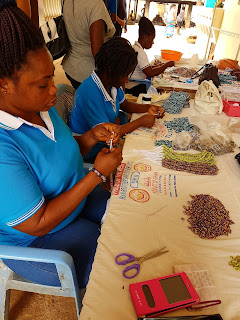Having already been to the biggest market in Accra, Makola market, a few of us decided to explore a smaller market, the Kaneshie market. In the local Ga language, Kaneshie means 'under the light' referring to how this market first started out as a night market. Located on Winneba Road, Kaneshie market spreads out along the main road as well as along all the side streets with a 3 storey building located in the midst of all the hustle and bustle.
Built in 1971, many controversies surround the design of the market. The 2 main issues that have been brought up are the lack of ventilation and the poor natural light conditions in the market. The market did seem dark and quite a few of the shops had to have their lights turned on even though it was mid morning when we were there. We also discovered that certain sections of the market felt hotter while other sections had a constant cool breeze flowing through.
Saying that, we were impressed overall with Kaneshie market and found the market to be well organized and clean. The stall holders also seemed to be much friendlier and in a better mood compared to their counterparts in Makola market.
A view of the hustle and bustle along Winneba Road from Kaneshie market
All around the main 3 storey building, makeshift stalls can be found selling ready made food, fresh vegetables, hardware and clothes, electrical and plumbing parts, etc.
Motar and pestle for pounding Fufu Earthern pots
Inside the multi storey market .... very clean
Baby crabs Snails used mainly in soups
Good selection of fresh veggies Beautiful smile from the avocado lady
Good selection of fish and seafood
The local butchers
Onions and oil palm sold by the size of the tin cans.
The onions in the can (bottom left) cost 5 ghc (about US$1.10).
Grinding up dry spices Fermented corn for making the local
Banku and Kenkey
Love the way legumes and rice are displayed
The shops on the second floor of the market sell mainly shoes, wigs, toiletries, stationery, utensils, pots and pans, etc. for sale. We did not stay long and headed up to the third floor.
On the third floor of the market, we found rows seamstresses cutting up beautiful African fabric and sewing them. Most of them use hand cranked sewing machines. This worked better for them because they would then not have to rely on electricity. This floor also had many shops selling fabric.
Love these locally designed and hand made cardboard mannequins
The button lady makes cloth cover buttons (a good find)
She also sells all the essentials needed for sewing... zips, interfacing, rolls of ribbons, etc.
We stumbled across a lace maker. He designs and makes beautiful decorative lace pieces which are sewn on to dresses and tunics. This is very popular amongst Ghanaians.
A very happy Phyllis. She is one of the few fabric sellers who is willing to sell GTP fabric by the yard as opposed to a minimum of 6 yards per design.
One of the many fabric stores in Kaneshie market












































































